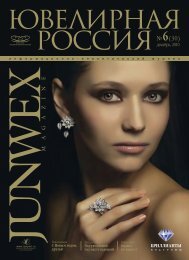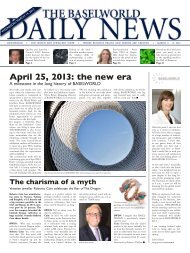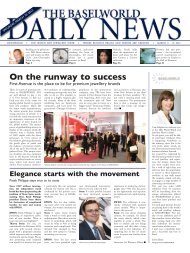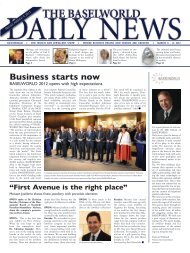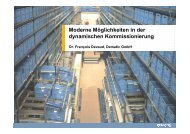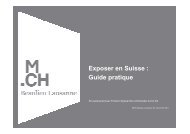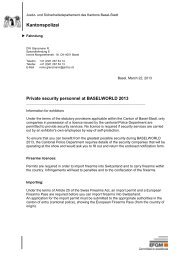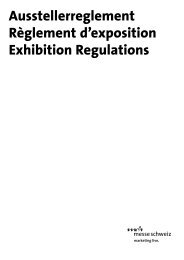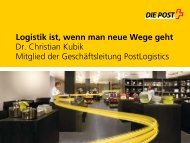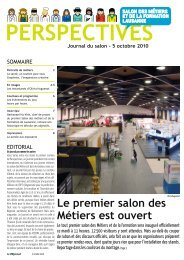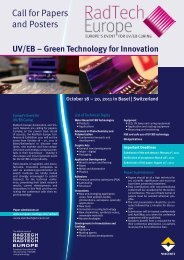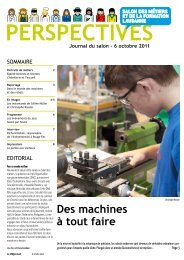WatchTime - August 2012
WatchTime - August 2012
WatchTime - August 2012
You also want an ePaper? Increase the reach of your titles
YUMPU automatically turns print PDFs into web optimized ePapers that Google loves.
SUPPLY SIDE<br />
Hairsprings<br />
THE QUESTION OF HOW TO<br />
OBTAIN HAIRSPRINGS IS<br />
VEXING MUCH OF THE SWISS<br />
WATCH INDUSTRY.<br />
ASTRAL TECHNOLOGIE SA, in Porrentruy, Switzerland, part of<br />
the Festina Group, also makes hairsprings. Customers can’t buy<br />
them separately, but must purchase complete assortments. Soprod,<br />
which is also part of the Festina Group, uses fairly large numbers of<br />
Astral’s springs in its automatic caliber A10. The Festina Group is<br />
now determining whether it can develop the capacity to make<br />
50,000 hairsprings at another subsidiary, MHVJ (Manufacture Horlogère<br />
Vallée de Joux) in Le Sentier, and even greater numbers at Soprod<br />
(in Les Reusilles).<br />
The Swiss company Atokalpa makes escapements that are<br />
used in movements made by Vaucher Manufacture Fleurier and<br />
other companies. Vaucher and Atokalpa are both owned by the<br />
Sandoz Family Foundation (as is the Parmigiani watch brand).<br />
Atokalpa has long specialized in making gear trains, pinions<br />
and micro-gears for mechanical watches. It began making assortments<br />
in 2005.<br />
Where some hairspring makers source their material is a<br />
closely guarded secret, but it’s widely known that wholesalers<br />
offer the necessary wire in smaller quantities.<br />
As far as prices are concerned, no one can compete with Nivarox-FAR.<br />
Customers report that hairsprings from Precision<br />
Engineering and Atokalpa are sometimes 10 times more expensive<br />
than comparable products from Nivarox-FAR. That’s significantly<br />
more than the price of a complete ETA 2892 automatic<br />
movement or a SW 300, a so-called “clone” of the ETA<br />
2892 made by the movement manufacturer Sellita. Haas hairsprings<br />
are also relatively expensive. Lower-priced merchandise<br />
can be purchased from Japanese producers: Seiko, for example,<br />
produces hairsprings, but most makers of Swiss movements<br />
have remained reluctant to use Japanese hairsprings. (TAG<br />
Heuer, however, announced in March that it would be buying<br />
Seiko assortments for use in its in-house movements because Nivarox<br />
had not renewed its contract with the company.)<br />
124 <strong>WatchTime</strong> <strong>August</strong> <strong>2012</strong><br />
Each hairspring is attached at two<br />
points: its inner end is affixed to the<br />
balance’s staff, its outer end to the stud.<br />
The dilemma about how to obtain hairsprings is vexing much<br />
of the Swiss watch industry. Sellita, for instance, which depends on<br />
Nivarox escapements, filed an appeal of Comco’s decision to allow<br />
this year’s delivery cutbacks. (In May the decision was extended to<br />
include 2013 as well.) The company made about 500,000 movements<br />
in 2010, some 800,000 movements in 2011, and plans to<br />
produce about 1 million this year. “We’re only receiving 85 percent<br />
as many Nivarox components as we received in 2010,” says Sellita’s<br />
owner, Miguel Garcia. He knows that the future of his business<br />
is at stake. “In the meantime, we’ve already taken so much money<br />
in hand that we can also plan the industrialized production of escapement<br />
assortments. But it will take a certain amount of time before<br />
that gets up and running.”<br />
At the moment, neither he nor anyone else will talk publicly<br />
about the possibility of cooperation between Sellita and Precision<br />
Engineering or Carl Haas. Whatever secret plans may be up<br />
Sellita’s sleeve, one thing is certain: when you drive from La<br />
Chaux-de-Fonds to Le Locle, you’ll see that Sellita is significantly<br />
enlarging its gray building in Le Crêt-du-Locle.<br />
A few brands can make hairsprings to meet their own needs.<br />
One is Montblanc’s subsidiary Minerva, in Villeret, Switzerland.<br />
Another is A. Lange & Söhne, in Glashütte, Germany,<br />
which has developed impressive hairspring expertise during the<br />
last several years. Lange’s former chief, the savvy German businessman<br />
Günter Blümlein, who died in 2001, acquired the necessary<br />
machinery (which was thought to be superfluous at the<br />
time) and a portion of the still-available Nivarox material from<br />
hairspring specialist Carl Haas. A. Lange’s hairsprings are used<br />
not just in its own watches but also by Jaeger-LeCoultre. (Both<br />
companies are owned by the Richemont Group.) Jaeger itself<br />
has made great strides in hairspring manufacturing: if necessary,<br />
it could start to operate independently in a relatively short time.<br />
Geneva-based Rolex, which manufactures hundreds of thousands<br />
of COSC-certified chronometers, makes more hairsprings<br />
by far than any other watch brand. They’re made of what Rolex<br />
calls “Parachrom,” an alloy of niobium and zircon. This alloy resists<br />
magnetic fields, and hairsprings made from it are 10 times<br />
less susceptible to shocks than conventional hairsprings. But<br />
Rolex sells only complete watches; it doesn’t sell its hairsprings.<br />
Who will fill the hairspring void no one knows. If, as many observers<br />
expect, Comco rules in favor of the Swatch Group, watch<br />
companies will have to find their hairsprings elsewhere, or invest<br />
huge amounts of money in equipment to make their own.



